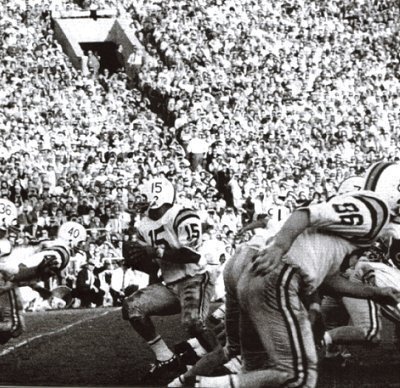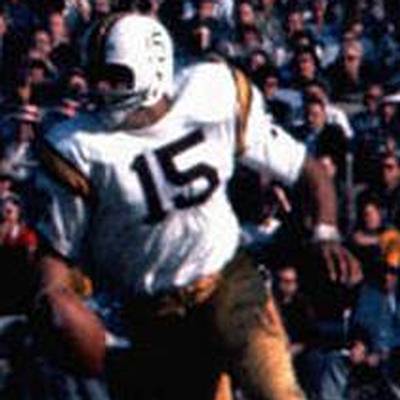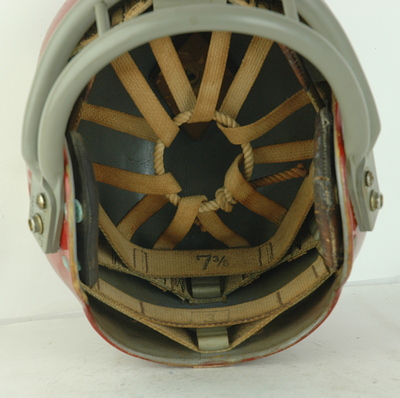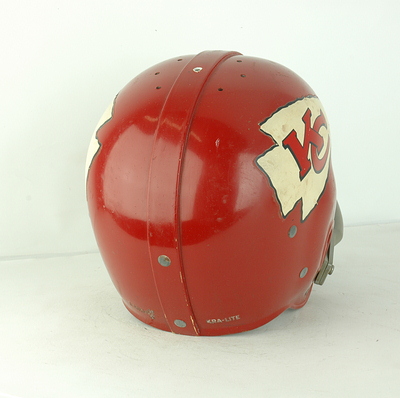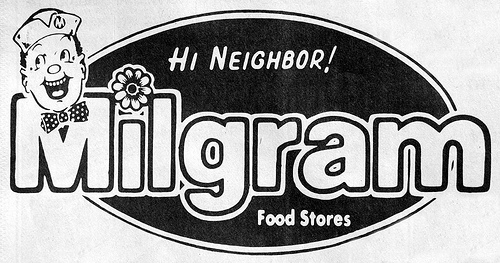
KC CHIEFS
Sandy Stephens
(Game Worn)
When one takes the measure of a man, the reference points can be numerous.
For a man such as Sanford Emory Stephens II, both his “measure” and
reference points provided a basis of inspiration for many, covering a wide
array of ethnic, social, and sporting perspectives. He was the first African
American to lead his college team to a National Championship and the hope
and guiding light of his hometown community. He was a man respected for his
demeanor, drive, and determination and motivated young men to emulate his
path. He was by any measure, a great football player. Recruited to the
University Of Minnesota by Head Coach Murray Warmath [see
HELMET HUT
Minnesota seasonal summaries at
http://www.helmethut.com/College/Minnesota/UM5667A.html
] with Uniontown (PA) Joint High School teammate Bill Munsey, Stephens led
the 1960 Gophers to the National Championship. As a three time letter winner
in football, basketball, and track, and a High School All American
quarterback, Stephens topped off his prep career by scoring the winning
touchdown in the first Big 33 Game. One might have easily predicted
collegiate success for Stephens but his ability and spectacular play -
making allowed him to break an unspoken barrier that had previously
prevented black quarterbacks from leading major college football programs.
He had chosen Minnesota
over fifty-eight other scholarship offers with the stated goal of being the
quarterback that would lead them to a Rose Bowl championship. “I was going
to be more than a Big Ten quarterback who was black. I was going to be a Big
Ten quarterback who took his team to the Rose Bowl,” said Stephens, decades
later. The squad won the National title yet lost the Rose Bowl to Washington
17 – 7. Stephens led the team back to the Rose Bowl following the 1961
season and took his Consensus All American, Big Ten MVP, and fourth place
Heisman Trophy vote honors with him while defeating UCLA.
Affectionately nicknamed “Mutt” after his dog, Stephens was a hero in
Uniontown and most of Western Pennsylvania, among African Americans and
Caucasians, rich and poor, and among those who followed football and those
who didn’t. Predictably drafted high by both the NFL and AFL, Stephens was
less than enthusiastic about the plans of both the Cleveland Browns and New
York Titans to use him at possible positions that did not include
quarterback. He instead spent 1962 and ’63 as the quarterback of the CFL
Montreal Alouettes, leading the Als to the Grey Cup final in his second
season. A new coaching staff brought resentment over his contract and he was
claimed on waivers by Toronto prior to the ’64 season. Attempting to join
the Minnesota Vikings as a free agent, Stephens’ plans were altered when he
suffered injuries described as “near fatal” in an auto accident, and there
was concern that he would not regain the ability to walk. However,
dedication, perseverance and all of the positive attributes Stephens always
stood for in Uniontown and at Minnesota came to the fore and two years
later, he was attempting a comeback with the Kansas City Chiefs.
Stephens was realistic
enough to understand that by 1967, much of his ability had eroded due to the
accident and age and he was willing to play any backfield position for
Kansas City. He entered camp listed as a quarterback candidate but he had
filled out to 225 pounds and with Pete Beathard as a capable and experienced
back-up to Len Dawson, Stephens was in reality, a candidate at one of the
running back positions. Still he intended on willing himself into the
quarterback position and Chiefs Head Coach Hank Stram was open to at least
the possibility that Stephens could make it happen. The Chiefs pre-season
schedule included games at Houston, against the Jets in Birmingham, Alabama,
against the Raiders in Portland, Oregon, at home against the NFL Bears, and
a Los Angeles date against the NFL Rams. Stram had the foresight to add an
all rookie contest against the Denver Broncos and he had the assistance of
well known Kansas City sportsman Lester Milgram. Lester’s father Nat had
founded the Milgram Food Store in 1913 and with the assistance of family
members, grew his one store into thirty-seven when they were purchased by
the Kroger Company in 1928. Taking over the Milgram groceries upon his
father’s death in 1958, Lester was deeply involved in community affairs and
supported both charitable organizations and numerous sporting events. Lester
had been an early member of the Kansas City Southwest High School Hall Of
Fame and to the present, awards are given in his name throughout the Kansas
City area by high schools, colleges, and amateur sports organizations,
reflecting his long standing involvement in athletics. When the Chiefs moved
to Kansas City, Lester, as an accomplished musician, led the early wolfpack
of followers by leading the Chiefs rendition of “Charge” on his trumpet.
Perhaps mimicking the
less than famous 1961 pre-season “Grocery Bowl” game that pitted the New
York Titans and Boston Patriots at Philadelphia’s Municipal Stadium in
front of 74,000 fans, the rookie contest was dubbed “The Milgram Grocery
Game.” Like its namesake, tickets were distributed as part of store
giveaways when groceries were purchased and though far less than 74,000
came to see the Chiefs and Broncos rookies fight for a roster spot at
Kansas City’s Municipal Stadium, the game was highlighted with a tie-in
to local radio station and game co-sponsor KCMO. They had agreed to a
microphone hook-up on the Chiefs game time quarterback that would
broadcast directly to its on-air and stadium audience. With Stram giving
Stephens the nod to play the position that had brought him so much past
glory, Stephens took the microphone that was secured in his shoulder
pads, took the football, and almost became the first true “Run And
Shoot” quarterback in pro football history. Instead, he immediately blew
out all of the circuits and transmitters as he clapped his hands and
exhorted his teammates to “Get this motherf___er going!” we are sure the
spelling was correct. The Chiefs legendary linebacker Bobby Bell was in
the stands watching the rookie game and leaned over to ask a teammate,
in an unbelieving manner, “What did he say?” before chuckling. Coach
Stram’s son Dale was on the Chiefs sideline, and like many in the
stands, had his transistor radio in hand. He had a similar, somewhat
surprised response though he was privy to “locker room language” on a
daily basis. Lamar Hunt's reaction was a bit more disconcerting. In an
attempt to maintain decorum, the microphone feed was immediately cut-off
as most of the crowd first gasped, and then enjoyed what they accepted
as a rather humorous remark. Bell, a close friend of Stephens from their
days at the University Of Minnesota, noted that Stephens was the last
man cut from the active roster for the 1967 season, ending his pro
football career.
The legacy of
Sandy Stephens football career is lengthy and impressive; induction to
the Western Pennsylvania All Sports Hall Of Fame, Rose Bowl Hall Of
Fame, University Of Minnesota Hall Of Fame, a member of the Minnesota
All Century Team, and the College Football Hall Of Fame. In every sense
of the word, he was a ground breaker for the African American
quarterbacks who followed him. Stephens said, “As a pioneer in the
field, first of the black Consensus All American quarterbacks, my
experiences leave me feeling like the Moses of Black Quarterbacks, able
to see the Promised Land, but unable to enter it.” Those who knew him
best noted that his real legacy was his ability to make others “feel
good, this is why Sandy truly was a legend.” Jesse Jackson, Sr. noted
that Sandy “made us feel so proud, with his poise and dignity as well as
his athletic ability.” Stephens died young, on June 6, 2000, at the age
of fifty-nine and public notice was given to his “non-negotiable dignity
and private pride that were never broken” by his inability to be granted
a chance to play quarterback in the NFL.
Part of his legacy
is this beautiful Kansas City Chiefs RK 4 helmet with two bar mask. The
helmet displays numerous bolt holes, indicating long use and relatively
older age. The name “Harris” is hand-written on the inside of the
helmet, perhaps confirming that Stephens was given one of the older
helmets in the Chiefs inventory and one previously worn by Dallas Texans
defensive back Jimmy Harris, the former Oklahoma University quarterback
who was such an integral part of the Sooners forty-seven game winning
streak. An extremely interesting and unique feature of this specific
helmet is the inscription of S44 within the KC logo decal itself.
Perhaps this was a stock number but it was and remains a part of the
original decal and was not added at a later date. Thus, like the very
unique Sandy Stephens, his Kansas City Chiefs helmet too, reminds us of
his special qualities.



